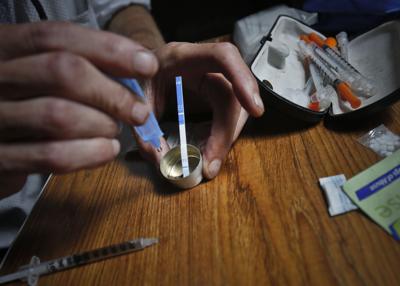Wisconsin will once again report an all-time record of opioid-related deaths when 2021 data is released, a state health official said Tuesday.
“As of right now, 73% of the deaths that we saw in 2021 involved synthetic opioids, primarily fentanyl. It is clearly, clearly the driver of what we’re seeing,” said Paul Krupski, director of opioid initiatives for the state Department of Health Services, during a Wisconsin Health News event.
Fentanyl is a powerful, synthetic opioid painkiller that can be administered safely by doctors to patients in extreme pain. But street drug manufacturers have created variations that have become a leading contributor to opioid-related deaths.
The prevalence of fentanyl has propelled Wisconsin into the “third wave” of its opioid epidemic, said Marshfield Clinic Health System chief medical officer Dr. William Melms.
Melms traced the first wave of the epidemic to the 1990s, when health care professionals were encouraged to treat pain as “the fifth vital sign” and the pharmaceutical industry aggressively marketed prescription painkillers. The second arrived around 2010, when heroin overdoses significantly increased.
An August 2021 DHS report found that suspected opioid overdoses increased significantly — even more than expected — since COVID-19 was first detected in Wisconsin in March 2020, creating a “dual public health crisis.”
Opioid overdose deaths in Wisconsin dropped by 10% to 839 in 2018, following a steady increase. Deaths increased again in 2019 to 916, and in 2020, the state recorded 1,227 opioid overdose deaths.
Although COVID has created challenges including isolation, financial struggles and heightened stress and anxiety, Dr. Ritu Bhatnagar, president of the Wisconsin Society of Addiction Medicine, said she has grown increasingly frustrated with framing the issue around people’s ability to cope with stress.
“To end up saying on some level that we just need to help increase their ability to deal with the stress really shifts the focus away from the systemic forces that may be causing those challenges to the individual, and what they’re bringing to their own livelihoods and their own abilities to cope,” Bhatnagar said.
Wisconsin is set to receive about $420 million over 18 years as part of a $26 billion national settlement with opioid manufacturers. Under the terms of a 2021 state law, 30% of those funds will go to the state and 70% will go to local governments. DHS is required to submit a plan for the funds to the Legislature’s Joint Finance Committee every year.
The agency held listening sessions earlier this year seeking feedback on how to best use the settlement funds. Suggestions included expanding prevention education efforts, addressing social determinants of health, expanding harm reduction strategies (including Narcan availability, fentanyl test strips and safe use sites), and increasing access to treatment and support for those in recovery.
State Rep. Jesse James, R-Altoona, is the chair of the Assembly Committee on Substance Abuse and Prevention. He spoke on Tuesday in favor of expanding the state’s “Good Samaritan” law to provide limited immunity for people who call 911 or bring someone to an emergency room when someone has overdosed.
“We need to remove the criminal element and make it about a human element,” James said.
Everyone who spoke agreed that expanding prevention education should be a priority for the state.
Mark O’Connell, president and CEO of the Wisconsin Counties Association, said that while education to prevent drug abuse should start with parents, not all parents are equipped to do so. State and local governments need to “partner with our educational facilities to try to increase awareness and education, so we don't have the problem and play catch-up when someone needs Narcan or we’re arranging a funeral,” he said.
Continued progress in curbing opioid abuse will require collaboration between the public and private sectors, Melms said.
“We are doing what we can, although there is no way to do enough,” he said. “And we need to do more.”



